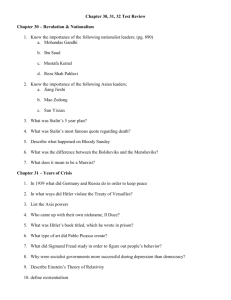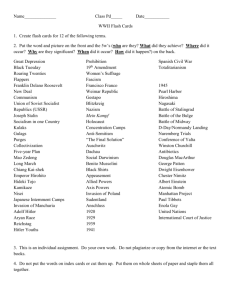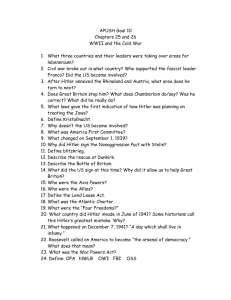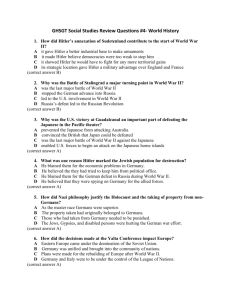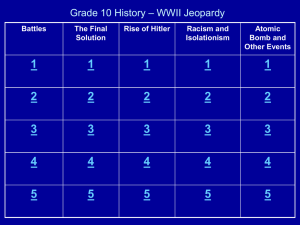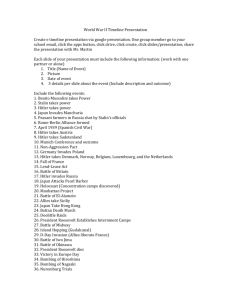US History World War II Test Review Guide
advertisement
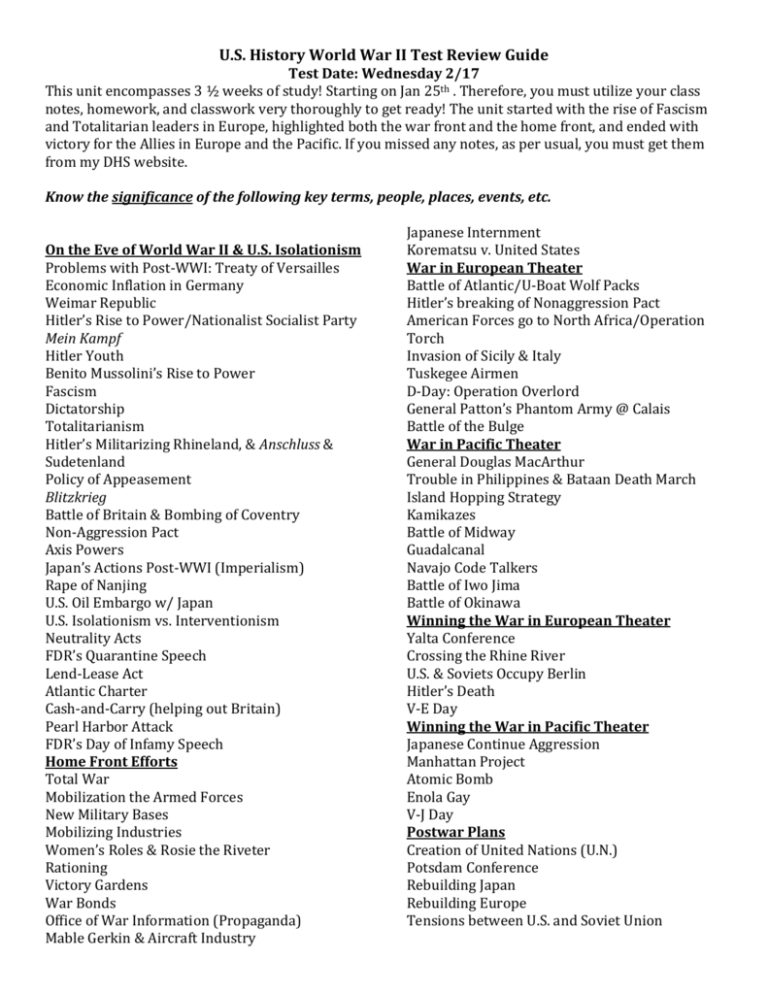
U.S. History World War II Test Review Guide Test Date: Wednesday 2/17 This unit encompasses 3 ½ weeks of study! Starting on Jan 25th . Therefore, you must utilize your class notes, homework, and classwork very thoroughly to get ready! The unit started with the rise of Fascism and Totalitarian leaders in Europe, highlighted both the war front and the home front, and ended with victory for the Allies in Europe and the Pacific. If you missed any notes, as per usual, you must get them from my DHS website. Know the significance of the following key terms, people, places, events, etc. On the Eve of World War II & U.S. Isolationism Problems with Post-WWI: Treaty of Versailles Economic Inflation in Germany Weimar Republic Hitler’s Rise to Power/Nationalist Socialist Party Mein Kampf Hitler Youth Benito Mussolini’s Rise to Power Fascism Dictatorship Totalitarianism Hitler’s Militarizing Rhineland, & Anschluss & Sudetenland Policy of Appeasement Blitzkrieg Battle of Britain & Bombing of Coventry Non-Aggression Pact Axis Powers Japan’s Actions Post-WWI (Imperialism) Rape of Nanjing U.S. Oil Embargo w/ Japan U.S. Isolationism vs. Interventionism Neutrality Acts FDR’s Quarantine Speech Lend-Lease Act Atlantic Charter Cash-and-Carry (helping out Britain) Pearl Harbor Attack FDR’s Day of Infamy Speech Home Front Efforts Total War Mobilization the Armed Forces New Military Bases Mobilizing Industries Women’s Roles & Rosie the Riveter Rationing Victory Gardens War Bonds Office of War Information (Propaganda) Mable Gerkin & Aircraft Industry Japanese Internment Korematsu v. United States War in European Theater Battle of Atlantic/U-Boat Wolf Packs Hitler’s breaking of Nonaggression Pact American Forces go to North Africa/Operation Torch Invasion of Sicily & Italy Tuskegee Airmen D-Day: Operation Overlord General Patton’s Phantom Army @ Calais Battle of the Bulge War in Pacific Theater General Douglas MacArthur Trouble in Philippines & Bataan Death March Island Hopping Strategy Kamikazes Battle of Midway Guadalcanal Navajo Code Talkers Battle of Iwo Jima Battle of Okinawa Winning the War in European Theater Yalta Conference Crossing the Rhine River U.S. & Soviets Occupy Berlin Hitler’s Death V-E Day Winning the War in Pacific Theater Japanese Continue Aggression Manhattan Project Atomic Bomb Enola Gay V-J Day Postwar Plans Creation of United Nations (U.N.) Potsdam Conference Rebuilding Japan Rebuilding Europe Tensions between U.S. and Soviet Union Questions: Respond to these questions to help guide your thinking and studying process, although these do not encompass every single key term listed on the opposite page. 1. After WWI, how did the Treaty of Versailles upset Japan and Germany? 2. How were fascist dictators like Mussolini and Hitler able to rise to power? 3. Make connections between these terms: Policy of Appeasement, Neville Chamberlain, Adolf Hitler, Rhineland, Anschluss, and Sudetenland 4. How did Hitler carry out his attack on Great Britain as WWII began? 5. Why did Hitler and Stalin create the non-aggression pact? 6. Make connections between these terms: Japanese Imperialism, Rape of Nanjing, U.S. Oil Embargo, & Pearl Harbor attack. 7. Explain the difference in the U.S. viewpoints of isolationism and interventionism. 8. What goal did FDR have in giving his Quarantine Speech? 9. How does the Lend-Lease Act. Atlantic Charter, and Cash-and-Carry reflect U.S. involvement in WWII? 10. How is WWII considered to be a total war? 11. How did the home front support the war effort? How did this directly affect the war front? 12. Describe the changing roles for women during WWII. 13. Make connections between these key terms: Pearl Harbor, Japanese Internment, Korematsu v. U.S. 14. What position did Hitler put himself in after invading the Soviet Union & breaking the Nonaggression Pact? 15. Why did the U.S. decide to enter the war in North Africa? 16. How was the Invasion of Italy a distraction that would benefit the Allies later on? 17. What planning went into D-Day? Why is this invasion so important for the Allies in Europe? 18. How did General Patton’s presence in Calais distract Hitler? 19. What happened to U.S. forces after the Japanese invaded the Philippines? 20. Why did the U.S. use the island hopping strategy? 21. Why was the Battle of Midway and the Battle at Guadalcanal so important for the U.S. in the Pacific? 22. What was a key goal at the Yalta Conference? What did this plan look like geographically? 23. Why did the U.S. and General Eisenhower let the Soviets go ahead and invade Berlin? What was the strategy behind that instead of sending in a drive of American forces? 24. What mentality did Japanese soldiers have? How does this reflect nationalism? 25. What kind of peace efforts were made by the Japanese? 26. Why did Truman decide to drop the atomic bomb? 27. What was the goal in creating the United Nations after WWII? 28. What concerns did the U.S. and Truman have about the Soviet Union after the war? 29. In relation to the previous question, why was the Potsdam conference not a success? 30. How did General MacArthur make efforts to rebuild Japan after the war?
